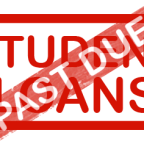While credit card debt is trending down, student loan debt has been on the rise since 2004 and in 2012 had almost tripled1. Many have referred to the impending financial crisis as the student loan bubble. However unlike the housing bubble the Federal Government is still making money on these student loans. They are becoming more aggressive in their collection efforts often filing lawsuits. They are aggressively pursuing co-signers of student loan debt. They are also gearing up collection efforts on Parent Plus Loans.
Similar to the housing bubble the student loan bubble has been predicted to explode. Financial crisis for the borrowers will be the result of defaulted student loans. The crisis will be that people saddled with high student loans may find it very difficult to obtain credit. The debt to income variable for a bank to make a loan would be very hard hurdle to overcome.
College graduates struggle to find jobs with a bachelor’s degree, while the rest of the country wonders why the recent grads are not helping the already slow recovery of the housing market. Unemployed graduates work to pay back loans that may already 90 days or more past due, so the idea of buying a house to start their futures seems out of reach. This also can be viewed as an explanation for the rise in multi-family housing nationwide. With tuition rates rising and student aid decreasing, colleges are losing enrollment numbers each year. This is one reason schools like Sweet Briar College in Lynchburg, VA have had to make the difficult decision to to close its doors. Sweet Briar did so in the spring of 20152. Sweet Briar is not the only college with a financial crisis, Corinthian College in California filed for bankruptcy in May 2015 and announced it would close its doors3. Entrepreneur and billionaire Mark Cuban has been very public about his opinion regarding debt forgiveness, as predicted the “inevitable college implosion” has begun. Cuban also registered the domain collegedebt.com which shows the ongoing increase of student loans compared to credit card and auto loans. As the dollars tick up anyone could feel the impending bubble burst on the horizon.
The majority of the $1.3 trillion in student loans are backed by the federal government so that leaves the public with the burden. Public burden tends to resort to federal legislation talks and words like bail-out, market crash and crisis. Bail-out is a familiar word we have heard before and with that comes years of recovery, but the options for to prevent the bubble from popping are running out. There new amendments being introduced, such as H.R. 449, this bill would amend the bankruptcy restrictions allowing the discharge of private student loans in a personal bankruptcy. Bills such as this come into play with the debate on how to fix the student loan crisis. In some cases student loans can be discharged, dependent upon major restrictions and proving financial hardship. Even with those restrictions, a high number of bankruptcies are coming from those millennials forced to live on credit cards while they pay those past due student loans. The student loan bubble has caught a lot of national attention, more so after the housing market crash. With a new generation starting college this fall, new solutions are bound to become available for those still struggling with loan payments. In fact, as a bankruptcy attorney office, we have dedicated a portion of our practice to working with those who are struggling with student loan debt in order to help to find a solution to overwhelming student loan debts.
- http://moneymorning.com/2013/03/05/the-scary-reality-of-the-student-loan-bubble-in-5-charts/
- http://www.businessinsider.com/mark-cuban-sweet-briar-college-college-debt-bubble-crisis-2015-3
- http://reason.com/archives/2015/05/22/is-the-student-loan-bubble-starting-to-p
- https://www.congress.gov/bill/114th-congress/house-bill/449/text





